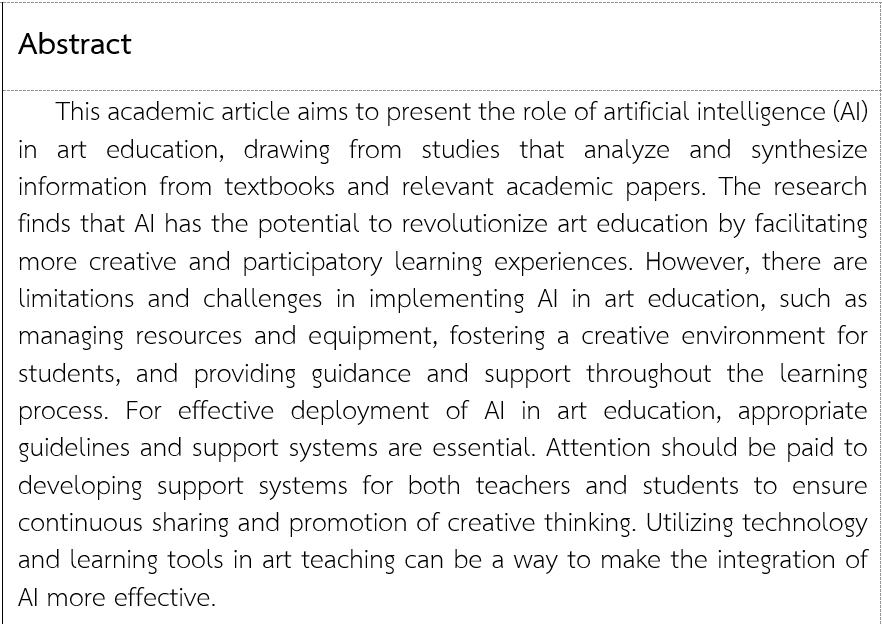Artificial Intelligence and Art Education
DOI:
https://doi.org/10.14456/jcct.2023.15Keywords:
Artificial Intelligence, Art Education, Creativity, Problems and ObstaclesAbstract
This academic article aims to present the role of artificial intelligence (AI) in art education, drawing from studies that analyze and synthesize information from textbooks and relevant academic papers. The research finds that AI has the potential to revolutionize art education by facilitating more creative and participatory learning experiences. However, there are limitations and challenges in implementing AI in art education, such as managing resources and equipment, fostering a creative environment for students, and providing guidance and support throughout the learning process. For effective deployment of AI in art education, appropriate guidelines and support systems are essential. Attention should be paid to developing support systems for both teachers and students to ensure continuous sharing and promotion of creative thinking. Utilizing technology and learning tools in art teaching can be a way to make the integration of AI more effective.
Downloads
References
1. Mikalonytė ES and Kneer M. Can Artificial Intelligence Make Art?: Folk Intuitions as to Whether AI-Driven Robots Can be Viewed as Artists and Produce Art. ACM Transactions on Human-Robot Interaction (THRI). 2022;11(4):1-19.
2. Wogu IAP, Misra S, Olu-Owolabi EF, Assibong PA, Udoh OD, Ogiri SO, Damasevicius R. Artificial Intelligence, Artificial Teachers and the Fate of Learners in the 21st Century Education Sector: Implications for Theory and Practice. International Journal of Pure and Applied Mathematics. 2018;119(16):2245-2259.
3. Chen L, Chen P, Lin Z. Artificial Intelligence in Education: A Review. IEEE Access. 2020;8:75264-75278.
4. Miller AI. The Artist in the Machine: The World of AI-Powered Creativity. Mit Press. 2019.
5. Fathoni AFCA. Leveraging Generative AI Solutions in Art and Design Education: Bridging Sustainable Creativity and Fostering Academic Integrity for Innovative Society. E3S Web of Conferences 426. 2023;01102 (2023):1-5. doi: 10.1051/e3sconf/202342601102.
6. Pedró F, Subosa M, Rivas A, Valverde P. Artificial Intelligence in Education: Challenges and Opportunities for Sustainable Development. France : United Nations Educational, Scientific and Cultural Organization. 2019.
7. Mazzone M and Elgammal A. Art, Creativity, and the Potential of Artificial Intelligence. Arts. 2019;8(1):26. doi: 10.3390/arts8010026.
8. Fan X and Zhong X. Artificial Intelligence-Based Creative Thinking Skill Analysis Model using Human–Computer Interaction in Art Design Teaching. Computers and Electrical Engineering. 2022;100:107957. doi: 10.1016/j.compeleceng.2022.107957.
9. Andriessen J and Sandberg J. Where is Education Heading and How About AI. International Journal of Artificial Intelligence in Education. 1999;10(2):130-150.

Downloads
Published
How to Cite
Issue
Section
Categories
License
Copyright (c) 2023 Journal of Computer and Creative Technology

This work is licensed under a Creative Commons Attribution-NonCommercial-NoDerivatives 4.0 International License.




























